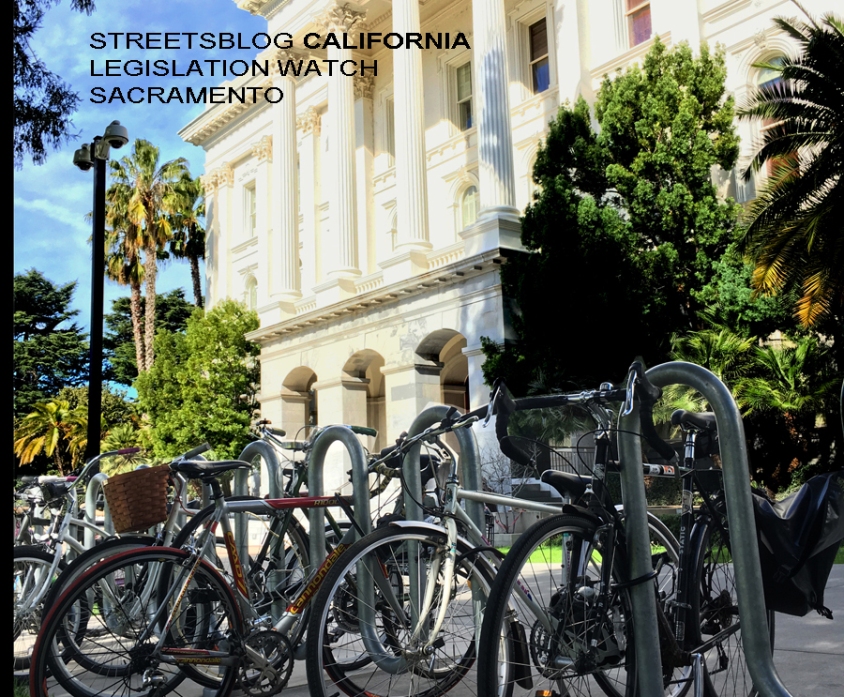Note: GJEL Accident Attorneys regularly sponsors coverage on Streetsblog San Francisco and Streetsblog California. Unless noted in the story, GJEL Accident Attorneys is not consulted for the content or editorial direction of the sponsored content.
Tasha Boerner's A.B. 73, which would allow bike riders to treat stop signs at certain intersections as yield signs, got its first hearing in the Assembly Transportation Committee on Monday, and passed. This was not surprising since the same bill - pretty much the same bill - got a lot of support from this committee in previous, ultimately unsuccessful, attempts to pass.
Hopefully this time around Governor Newsom will heed the evidence gathered in other states that have passed similar laws and seen big safety benefits from allowing bike riders to treat stop signs as yield signs. Delaware, for example, saw a 23 percent reduction in bike-car collisions after a similar law was passed.
"This is not about blowing through stop signs; this is about yielding, which is clearly defined in law," the bill's author told the committee. "It allows bike riders to slow down at four-way stops on quiet streets and, if it is safe - and only if it is safe, to then proceed through the intersection."
The bill calls for a statewide, six-year pilot, allowing time for the California Highway Patrol to gather data and evaluate its impact. It is limited to four-way stops on two-lane streets, and only to stop signs - this bill would not change anything in relation to signals. It would apply to riders eighteen and older, thus kneecapping one of the objections that has felled the bill in the past - that somehow children are not able to figure out how to behave at a "yield" sign (which is bunk). A minor would receive a warning rather than a citation on a first violation.
The goal is safety, said Assemblymember Boerner. "When safe bike behavior is predictable, everyone is better off," she said.
Marc Vukcevich of Streets for All, who spoke in support of the bill, quoted this classic Access article to underline the fact that the bill is also aimed at decriminalizing existing safe behavior. Bike riders that currently do not stop completely at stop signs are not scofflaws, and they are not behaving out of mere convenience. Their logical behavior is explained by physics.
According to physicist Joel Fajans of UC Berkeley, "a full stop at every stop sign is physically demanding and prohibitive to bike riding," said Vucevich. "In addition, the interpretation that insists that bike riders stop at stop signs prevents police from being able to clarify the difference between a safe yield and blowing through a stop sign."
"That unsafe behavior will continue if we can't offer a practical and safe alternative," he said.
Counterintuitive, perhaps, but borne out by evidence: it can be much safer for a bike rider to proceed through an intersection with some momentum than to have to start up from a complete stop. "The intersection is the most dangerous spot for crashes," said Vukcevich. "The longer I spend in the intersection, the more danger I'm in."
The next stop for this bill should be the Assembly floor, which past versions have also easily passed.
Prioritizing Transportation Investments
Another bill that passed this committee was A.B. 1525 from Assemblymember Mia Bonta. This bill would require state transportation agencies to evaluate transportation investments on the basis of whether they benefit or harm "priority populations," meaning low-income and disadvantaged communities. It stirred up opposition from Transportation California and the Self-Help Counties Coalition. Both feared it could cause delays in the "pipeline of projects" in the State Highway Operation and Protection Program (SHOPP) - projects that have been approved or are in some stage of planning.
"This does not apply to current projects," said Bonta. "This merely creates a process by which projects will be evaluated according to state goals, and brings transparency around equity. It also puts a stake in the ground" so that future projects can avoid the harms caused by many past projects that were rammed through communities.
Trying - and Failing - to Kill High-Speed Rail
A bill that did not pass was another attempt by Bakersfield Assembly representative Vince Fong, who has made no secret of his scorn for the California High-Speed Rail project. When it was his turn to address a recent hearing in the same committee that was grappling with the very serious issues around funding the project, he used his time to talk about undefined "damaging impacts" from the project in his district and to ask the Legislative Analyst's Office whether the legislature had ever attempted to take away money from the project.
But he knew the answer, even if the LAO representative did not: every session he has tried to do so himself, and he has been joined by other lawmakers in multiple failed attempts.
This time his bill, A.B. 501, aimed to take the annual allocation from cap-and-trade away from the California High-Speed Rail Authority and use it for flood protection. "For anything else," he said, "anything that's a higher priority" than the rail project, "which is clearly on life support" and "has no possibility" of being completed.
Keith Dunn of the Self-Help Counties Coalition said "this author should [instead] be supporting the (CAHSRA) Authority's application for federal funding. We have to remember that California is a donor state - that federal funding is our money. It has had its bumps in the road, but thousands of jobs have been created. Projects like this take time."
Chair Laura Friedman pointed out that this kind of change cannot be made via a policy bill in a committee - that the cap-and-trade investments were handled in the budget process. "We do need a cost benefit analysis of that project," she said, "but this is the wrong approach."






